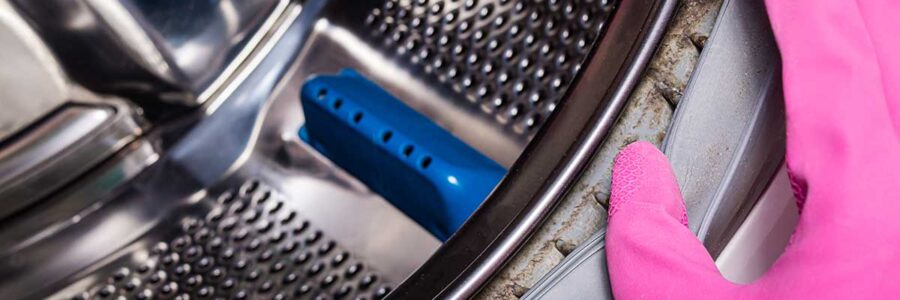If your laundry room has a lingering musty smell, the culprit might not be your clothes—it could be your washing machine. Often overlooked, mold buildup in washing machines is a common issue that can lead to serious health concerns. While air fresheners and dryer sheets may temporarily mask the odor, they won’t eliminate the root cause: a moldy machine.
Understanding the Health Risks of Washing Machine Mold
Mold thrives in a washing machine’s damp, enclosed spaces, particularly in front-loading models. As mold grows, it can release mycotoxins—hazardous compounds that risk your health. These mycotoxins can lead to various health problems, including inflammation, immune system suppression, and neurological issues. Prolonged exposure to these toxins can exacerbate health problems and contribute to chronic conditions. Mold in washing machines has become a significant enough issue that has resulted in successful lawsuits against some manufacturers, underlining the importance of addressing this issue in your home.[1]
Why Mold Develops in Washing Machines
Washing machines, especially front-loaders, are designed to be efficient and water-saving. However, these benefits come with a downside: the design of these machines makes them prone to mold growth. The tight seals that prevent leaks also trap moisture inside, providing the perfect environment for mold to thrive. Over time, detergent, fabric softener, and dirt can accumulate in damp areas, such as the gasket around the door and the detergent drawer, making them prime locations for mold growth.
Top-loading machines are generally less prone to mold issues because their lids do not form an airtight seal, allowing for better ventilation. However, they are not immune to mold, especially if the lid is kept closed between uses or the machine isn’t cleaned regularly. Regardless of the type of washing machine you own, proactive maintenance is key to preventing mold from becoming a problem.
Tips to Prevent and Remove Mold in Your Washing Machine
Preventing mold in your washing machine doesn’t require drastic measures—simple, regular maintenance can go a long way. Here are some effective strategies to keep your machine mold-free:
- Choose Natural Cleaners Over Bleach: Bleach is a common household cleaner, but it’s not always the best option for washing machines. It can be harsh on the machine’s components and may not completely remove mold. Instead, use white vinegar or borax in a hot water cycle. Vinegar is a natural disinfectant that kills mold spores, while borax has antifungal properties that help prevent mold from returning. Alternating between these natural cleaners every few months can keep your washing machine fresh and clean.
- Implement a Regular Cleaning Routine: Consistency is crucial in preventing mold. Schedule a cleaning cycle every two to three months or more frequently if you detect any musty odors. Pay special attention to areas where mold is most likely to develop, such as the detergent drawer and the gasket. Regularly wiping down these areas can prevent the buildup of mold and mildew.
- Keep the Door Open After Use: One of the simplest ways to prevent mold is to keep the washing machine door open when it’s not in use. This allows air to circulate inside the machine, helping to dry out any remaining moisture. This step is particularly important for front-loading machines because their doors form an airtight seal that can trap moisture inside.
- Use a Fan for Extra Drying Power: To ensure your washing machine stays dry between uses, consider placing a small fan inside the machine. This can help circulate air and speed up the drying process, making it harder for mold to establish itself. There are specially designed fans for washing machines, but a regular fan can also do the job effectively.
- Consider Your Washing Machine’s Design: Consider how susceptible the model is to mold if you’re in the market for a new washing machine. While front-loaders are known for their efficiency and water conservation, they require more diligence in preventing mold. If you prefer a front-loader, be prepared to follow a strict maintenance routine to keep it mold-free.
Conclusion
A moldy washing machine is more than just a nuisance—it’s a potential health risk with long-lasting effects. By taking proactive steps to prevent mold growth, such as using natural cleaning solutions, keeping the machine dry, and maintaining a regular cleaning routine, you can protect your health and ensure your washing machine stays in top condition. Whether you have a top loader or a front loader, these strategies will help you maintain a clean, mold-free laundry environment, allowing you to focus on the more enjoyable aspects of life.
References:
- Bennett, J. W., and M. Klich. “Mycotoxins.” Clinical Microbiology Reviews, vol. 16, no. 3, July 2003, pp. 497–516. PubMed Central.


